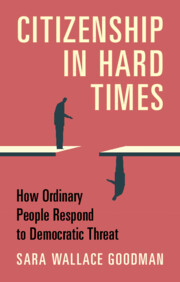Book contents
- Citizenship in Hard Times
- Citizenship in Hard Times
- Copyright page
- Dedication
- Contents
- Figures
- Tables
- Acknowledgments
- 1 Introduction
- 2 Citizenship and Democratic Instability
- 3 Measuring Citizenship Norms
- 4 Patterns of Partisan Citizenship
- 5 The Threat of Polarization
- 6 Foreign Interference in Elections
- 7 Conclusion
- Book part
- References
- Index
4 - Patterns of Partisan Citizenship
Published online by Cambridge University Press: 22 January 2022
- Citizenship in Hard Times
- Citizenship in Hard Times
- Copyright page
- Dedication
- Contents
- Figures
- Tables
- Acknowledgments
- 1 Introduction
- 2 Citizenship and Democratic Instability
- 3 Measuring Citizenship Norms
- 4 Patterns of Partisan Citizenship
- 5 The Threat of Polarization
- 6 Foreign Interference in Elections
- 7 Conclusion
- Book part
- References
- Index
Summary
Chapter 4 introduces the readers to the specific political parties within each case study and considers the extent to which the fourteen items of “good citizenship” are already partisan, that is, before introducing democratic threats. We observe consistent patterns of partisan citizenship, even when controlling for demographic factors that might explain citizenship preferences. That is, supporters of left parties value protesting and solidarity-oriented beliefs like helping others; supporters of right parties strongly support allegiant items of belonging, from obeying laws to items of national belonging. In majoritarian systems (the US and UK), these patterns are strong and systematic. However, a crucial observation underlies these differences: there are sufficient overlaps between the left and right when it comes to liberal democratic beliefs and behavioral items of good citizenship. This “holding of the center” is critical. It suggests a strong base of agreement for preserving national unity and sufficient overlaps for establishing common goals despite polarization in everyday politics.
Keywords
- Type
- Chapter
- Information
- Citizenship in Hard TimesHow Ordinary People Respond to Democratic Threat, pp. 89 - 111Publisher: Cambridge University PressPrint publication year: 2022

